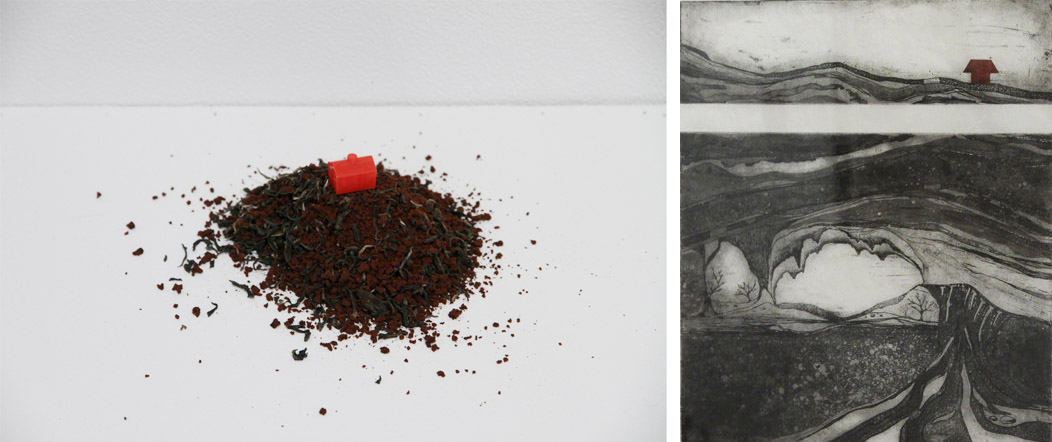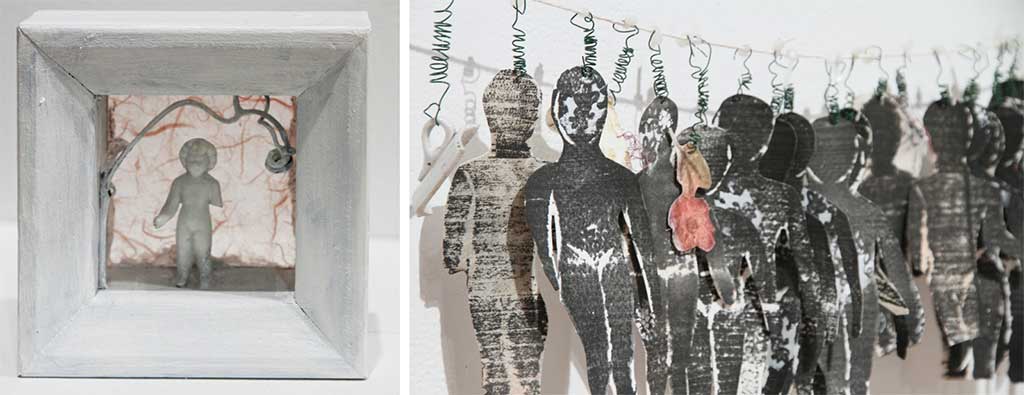O.W.N. (Object Work Notation)
February 21 – March 29, 2014
Open Studio
There is something strange about this exhibition, even at first sight. Some of the works don’t seem to be prints or related to printmaking at all. However hard I try to find elements of printmaking, in some pieces I can’t. What does a monogrammed piece of cutlery have to do with printmaking? Other pieces clearly belong among textile art like Jae Lee’s Pojagi or Liz Parkinson’s Thicket Setting. There is a box with tubes of paint, another with children’s building toys, an oar, a little heap of dirt with a small red plastic building on it. Of course there are some prints too, but still it’s strange. Works and objects occupy the walls, some of them close to the floor and others with writing close to the ceiling. After a while I just gave up analyzing the techniques. Who cares about the boundaries of printmaking when the show is so enjoyable? It is a wonderfully installed exhibition with playful details and a lot to see, so I just let myself look.
I finally understood the concept when I read the interesting curatorial statement from Richard Sewel: “O.W.N as occurrence(s) evolved from locusethics, a theory about location as morality. Here occurrence is about manner as a located heuristic, a notation that enables individual objects as linked to individual. Here the observation within locations is as narrative – sequence about a myriad of and as one’s experience. Here as cultural significant – each local is as a foci – a clarifying about one’s observation.” O.W.N. is a visual occurrence of 33 located objects by eleven Open Studio members. O.W.N. as occurrence is evolved from pre-literate chanting. As in chanting, some works are like a gesture or even a rhythm, while others have a rather complex story.
 Laura Bydlowska’s object (left) and her etching, Red Habitat.
Laura Bydlowska’s object (left) and her etching, Red Habitat.
Laura Bydlowska’s etching Red Habitatdepicts a hilly landscape with a little red chine-collé house that represents hotels in Monopoly games. A few steps further and it’s recreated from some dirt (maybe from the landscape itself) and the monopoly piece – a playful gesture. Liz Menard layered the poem “Land of the Silver Birch” and the musical notes from the song based on it over her Collograph that resembles the bark of birch trees – while a paddle hangs on the opposite wall. These are memories of summer camps, the artist says.
 Liz Menard, Collograph with Pauline Johnson poem and Land of the Silver Birch Sheet Music.
Liz Menard, Collograph with Pauline Johnson poem and Land of the Silver Birch Sheet Music.
Irina Schestakowich’s narrative is really touching. Her object is a little ceramic boy figurine that, along with her mother, survived the bombing of Dresden. Schestakowitch’s work, Boy Print, inspired by the figurine, also has a survival story. When the artist’s studio on Toronto Island collapsed in a 2013 storm, that print was the only thing she wanted to save.
 Irina Schestakowich’s object, Boy Doll (left) and Boy Prints
Irina Schestakowich’s object, Boy Doll (left) and Boy Prints
Libby Hague explained the making of her installation, saying that she followed a map or sketches of original ideas that came together in her studio as the material she was handling absorbed the happiness and anxiety of her life. Yael Brotman, inspired by her climb to the cupola of the Sheldonian Theatre in Oxford, created a construction of angled beams with recycled, etched, Japanese paper. Penelope Stewart transformed the geographical map of Canberra into a large piece called Apian Cartography, focusing on natural and architectural patterns.
 Libby Hague, Studio slice (left) and Synchromesh, Gabrielle, woodcut print on wire-laminated paper, rope, cord, netting, papier maché, various upholstery tack, 36 x 35 x 3 inches.
Libby Hague, Studio slice (left) and Synchromesh, Gabrielle, woodcut print on wire-laminated paper, rope, cord, netting, papier maché, various upholstery tack, 36 x 35 x 3 inches.
 Yael Brotman’s object, cookie tin of children’s blocks (left) and Trestle, Etching on Kurotani paper, 2013
Yael Brotman’s object, cookie tin of children’s blocks (left) and Trestle, Etching on Kurotani paper, 2013
The exhibited objects and artwork are engaging by themselves, but what makes this exhibition outstanding is the way it has been installed, the way it juxtaposes its many elements.
Emese Krunák-Hajagos
Photo: Margaret Irving
*Exhibition information: February 21 – March 29, 2014, Open Studio, 401 Richmond Street West, Suite 104, Toronto. Gallery hours: Tues – Sat, 12 – 5 p.m.




The pictures are lovely.